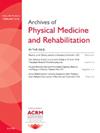Implementation of an Electronic Prospective Surveillance System for Cancer Rehabilitation: Preliminary Results of a Mixed Methods Study 8258
IF 3.6
2区 医学
Q1 REHABILITATION
Archives of physical medicine and rehabilitation
Pub Date : 2025-04-01
DOI:10.1016/j.apmr.2025.01.021
引用次数: 0
Abstract
Objectives
To evaluate the implementation of an electronic prospective surveillance system, called REACH, into routine cancer care, and understand barriers and facilitators to implementation.
Design
A 16-month, single-arm, mixed methods, formative evaluation of implementation.
Setting
REACH was implemented at 4 regional cancer centers in Canada.
Participants
Adult (≥18y) breast, colorectal, lymphoma, or head and neck cancer survivors, defined as from the date of diagnosis until 2 years after completing all treatments.
Interventions
REACH is a web-based application that systematically screens for and identifies cancer-related impairments and links patients to rehabilitation resources based on reported needs. Registered patients are prompted via email at regular intervals to complete a brief assessment throughout treatment and during follow-up surveillance. The specific impairments assessed, and frequency of assessments are tailored to each cancer type and vary by treatment status. The REACH system then automatically provides patients with suggestions based on their assessment scores, cancer type, and demographic information. The resources offered to patients follow a tiered approach based on the assessment with 3 distinct levels: (1) self-management education (ie, links to videos, handouts, and websites); (2) suggested community workshops and programs (online or in-person); and (3) a recommendation to schedule a visit with their oncologist or family physician for further assessment and management of the impairment identified.
Main Outcome Measures
Data collection is ongoing. Implementation outcomes include system uptake, acceptability, appropriateness, feasibility, fidelity, and sustainability. System usage data and documentation of meetings with clinic leadership were analyzed up to 12 months postimplementation. Qualitative data were categorized using the Consolidated Framework for Implementation Research.
Results
We report on the preliminary results for the implementation at the first and largest center (Princess Margaret Cancer Centre). To date, n=320 patients have registered to REACH at Princess Margaret Cancer Centre, and n=266 (68% women; 42% breast; mean age, 58+13y; 43% currently receiving treatment) have provided consent for research. Preliminary analyses indicate REACH is feasible (mean duration to complete assessments is 5min, n=6 patient inquiries related to technical issues), and has high fidelity (87% assessments completed, 70% of patients viewing ≥1 resource recommended by REACH). Meaningful clinic leadership engagement, compatibility with clinic workflows and systems, and relative priorities among clinic staff have been identified as critical for successful implementation.
Conclusions
Preliminary results suggest that REACH is feasible and has high fidelity, and that implementation is supported by meaningful stakeholder engagement. A description of the implementation plan along with updated data (postimplementation patient evaluation survey) will be presented.
Disclosures
none.
求助全文
约1分钟内获得全文
求助全文
来源期刊
CiteScore
6.20
自引率
4.70%
发文量
495
审稿时长
38 days
期刊介绍:
The Archives of Physical Medicine and Rehabilitation publishes original, peer-reviewed research and clinical reports on important trends and developments in physical medicine and rehabilitation and related fields. This international journal brings researchers and clinicians authoritative information on the therapeutic utilization of physical, behavioral and pharmaceutical agents in providing comprehensive care for individuals with chronic illness and disabilities.
Archives began publication in 1920, publishes monthly, and is the official journal of the American Congress of Rehabilitation Medicine. Its papers are cited more often than any other rehabilitation journal.

 求助内容:
求助内容: 应助结果提醒方式:
应助结果提醒方式:


